标签:


public class PriorityQueue<E> extends AbstractQueue<E> implements java.io.Serializable {
1 // 默认初始化大小 2 privatestaticfinalintDEFAULT_INITIAL_CAPACITY = 11; 3 4 // 用数组实现的二叉堆,下面的英文注释确认了我们前面的说法。 5 /** 6 * Priority queue represented as a balanced binary heap: the two 7 * children of queue[n] are queue[2*n+1] and queue[2*(n+1)]. The 8 * priority queue is ordered by comparator, or by the elements‘ 9 * natural ordering, if comparator is null: For each node n in the 10 * heap and each descendant d of n, n <= d. The element with the 11 * lowest value is in queue[0], assuming the queue is nonempty. 12 */ 13 private transient Object[] queue ; 14 15 // 队列的元素数量 16 private int size = 0; 17 18 // 比较器 19 private final Comparator<? super E> comparator; 20 21 // 修改版本 22 private transient int modCount = 0;
1 /** 2 * 默认构造方法,使用默认的初始大小来构造一个优先队列,比较器comparator为空,这里要求入队的元素必须实现Comparator接口 3 */ 4 public PriorityQueue() { 5 this(DEFAULT_INITIAL_CAPACITY, null); 6 } 7 8 /** 9 * 使用指定的初始大小来构造一个优先队列,比较器comparator为空,这里要求入队的元素必须实现Comparator接口 10 */ 11 public PriorityQueue( int initialCapacity) { 12 this(initialCapacity, null); 13 } 14 15 /** 16 * 使用指定的初始大小和比较器来构造一个优先队列 17 */ 18 public PriorityQueue( int initialCapacity, 19 Comparator<? super E> comparator) { 20 // Note: This restriction of at least one is not actually needed, 21 // but continues for 1.5 compatibility 22 // 初始大小不允许小于1 23 if (initialCapacity < 1) 24 throw new IllegalArgumentException(); 25 // 使用指定初始大小创建数组 26 this.queue = new Object[initialCapacity]; 27 // 初始化比较器 28 this.comparator = comparator; 29 } 30 31 /** 32 * 构造一个指定Collection集合参数的优先队列 33 */ 34 public PriorityQueue(Collection<? extends E> c) { 35 // 从集合c中初始化数据到队列 36 initFromCollection(c); 37 // 如果集合c是包含比较器Comparator的(SortedSet/PriorityQueue),则使用集合c的比较器来初始化队列的Comparator 38 if (c instanceof SortedSet) 39 comparator = (Comparator<? super E>) 40 ((SortedSet<? extends E>)c).comparator(); 41 else if (c instanceof PriorityQueue) 42 comparator = (Comparator<? super E>) 43 ((PriorityQueue<? extends E>)c).comparator(); 44 // 如果集合c没有包含比较器,则默认比较器Comparator为空 45 else { 46 comparator = null; 47 // 调用heapify方法重新将数据调整为一个二叉堆 48 heapify(); 49 } 50 } 51 52 /** 53 * 构造一个指定PriorityQueue参数的优先队列 54 */ 55 public PriorityQueue(PriorityQueue<? extends E> c) { 56 comparator = (Comparator<? super E>)c.comparator(); 57 initFromCollection(c); 58 } 59 60 /** 61 * 构造一个指定SortedSet参数的优先队列 62 */ 63 public PriorityQueue(SortedSet<? extends E> c) { 64 comparator = (Comparator<? super E>)c.comparator(); 65 initFromCollection(c); 66 } 67 68 /** 69 * 从集合中初始化数据到队列 70 */ 71 private void initFromCollection(Collection<? extends E> c) { 72 // 将集合Collection转换为数组a 73 Object[] a = c.toArray(); 74 // If c.toArray incorrectly doesn‘t return Object[], copy it. 75 // 如果转换后的数组a类型不是Object数组,则转换为Object数组 76 if (a.getClass() != Object[].class) 77 a = Arrays. copyOf(a, a.length, Object[]. class); 78 // 将数组a赋值给队列的底层数组queue 79 queue = a; 80 // 将队列的元素个数设置为数组a的长度 81 size = a.length ; 82 }
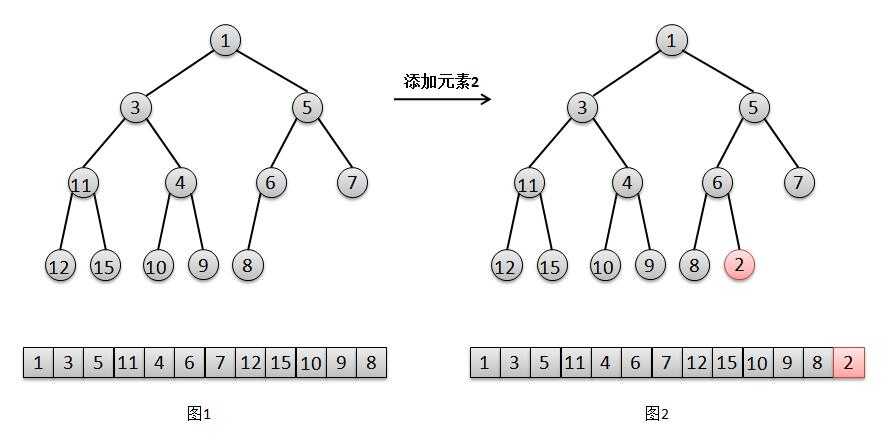
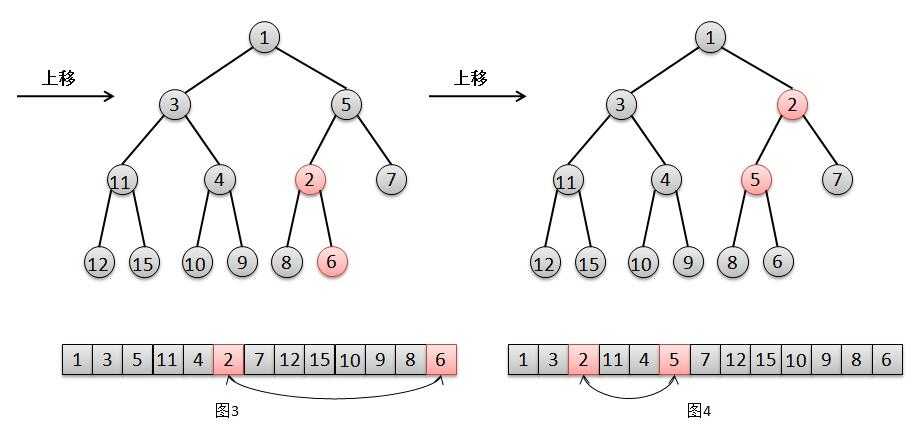
1 /** 2 * 添加一个元素 3 */ 4 public boolean add(E e) { 5 return offer(e); 6 } 7 8 /** 9 * 入队 10 */ 11 public boolean offer(E e) { 12 // 如果元素e为空,则排除空指针异常 13 if (e == null) 14 throw new NullPointerException(); 15 // 修改版本+1 16 modCount++; 17 // 记录当前队列中元素的个数 18 int i = size ; 19 // 如果当前元素个数大于等于队列底层数组的长度,则进行扩容 20 if (i >= queue .length) 21 grow(i + 1); 22 // 元素个数+1 23 size = i + 1; 24 // 如果队列中没有元素,则将元素e直接添加至根(数组小标0的位置) 25 if (i == 0) 26 queue[0] = e; 27 // 否则调用siftUp方法,将元素添加到尾部,进行上移判断 28 else 29 siftUp(i, e); 30 return true; 31 }
1 /** 2 * 数组扩容 3 */ 4 private void grow(int minCapacity) { 5 // 如果最小需要的容量大小minCapacity小于0,则说明此时已经超出int的范围,则抛出OutOfMemoryError异常 6 if (minCapacity < 0) // overflow 7 throw new OutOfMemoryError(); 8 // 记录当前队列的长度 9 int oldCapacity = queue .length; 10 // Double size if small; else grow by 50% 11 // 如果当前队列长度小于64则扩容2倍,否则扩容1.5倍 12 int newCapacity = ((oldCapacity < 64)? 13 ((oldCapacity + 1) * 2): 14 ((oldCapacity / 2) * 3)); 15 // 如果扩容后newCapacity超出int的范围,则将newCapacity赋值为Integer.Max_VALUE 16 if (newCapacity < 0) // overflow 17 newCapacity = Integer. MAX_VALUE; 18 // 如果扩容后,newCapacity小于最小需要的容量大小minCapacity,则按找minCapacity长度进行扩容 19 if (newCapacity < minCapacity) 20 newCapacity = minCapacity; 21 // 数组copy,进行扩容 22 queue = Arrays.copyOf( queue, newCapacity); 23 }
1 /** 2 * 上移,x表示新插入元素,k表示新插入元素在数组的位置 3 */ 4 private void siftUp(int k, E x) { 5 // 如果比较器comparator不为空,则调用siftUpUsingComparator方法进行上移操作 6 if (comparator != null) 7 siftUpUsingComparator(k, x); 8 // 如果比较器comparator为空,则调用siftUpComparable方法进行上移操作 9 else 10 siftUpComparable(k, x); 11 } 12 13 private void siftUpComparable(int k, E x) { 14 // 比较器comparator为空,需要插入的元素实现Comparable接口,用于比较大小 15 Comparable<? super E> key = (Comparable<? super E>) x; 16 // k>0表示判断k不是根的情况下,也就是元素x有父节点 17 while (k > 0) { 18 // 计算元素x的父节点位置[(n-1)/2] 19 int parent = (k - 1) >>> 1; 20 // 取出x的父亲e 21 Object e = queue[parent]; 22 // 如果新增的元素k比其父亲e大,则不需要"上移",跳出循环结束 23 if (key.compareTo((E) e) >= 0) 24 break; 25 // x比父亲小,则需要进行"上移" 26 // 交换元素x和父亲e的位置 27 queue[k] = e; 28 // 将新插入元素的位置k指向父亲的位置,进行下一层循环 29 k = parent; 30 } 31 // 找到新增元素x的合适位置k之后进行赋值 32 queue[k] = key; 33 } 34 35 // 这个方法和上面的操作一样,不多说了 36 private void siftUpUsingComparator(int k, E x) { 37 while (k > 0) { 38 int parent = (k - 1) >>> 1; 39 Object e = queue[parent]; 40 if (comparator .compare(x, (E) e) >= 0) 41 break; 42 queue[k] = e; 43 k = parent; 44 } 45 queue[k] = x; 46 }
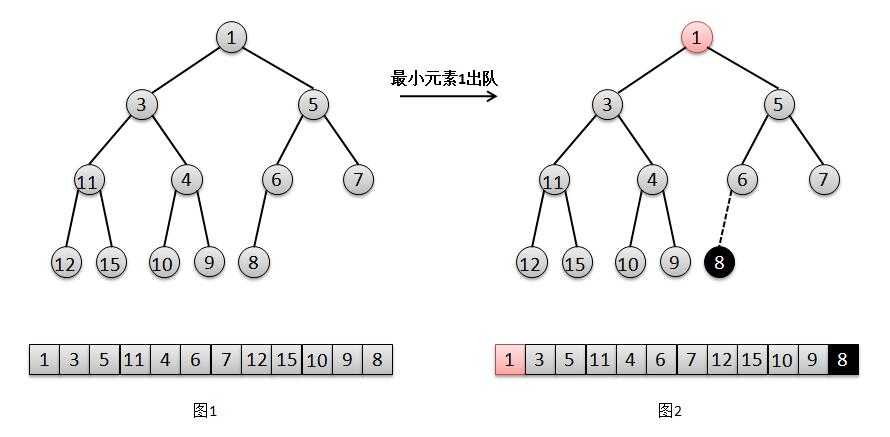
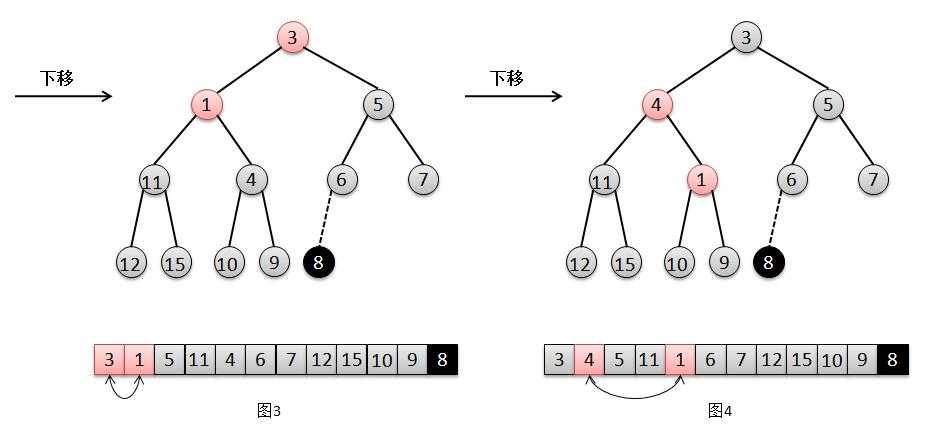
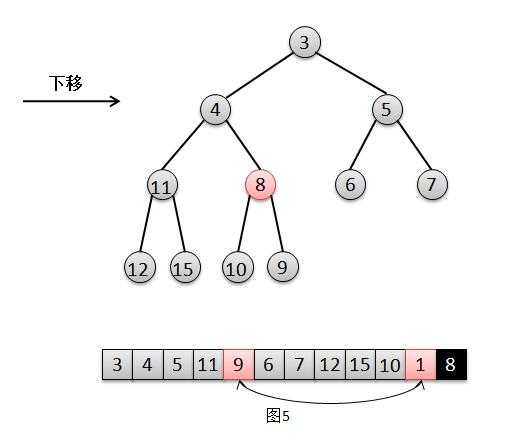
1 /** 2 * 删除并返回队头的元素,如果队列为空则抛出NoSuchElementException异常(该方法在AbstractQueue中) 3 */ 4 public E remove() { 5 E x = poll(); 6 if (x != null) 7 return x; 8 else 9 throw new NoSuchElementException(); 10 } 11 12 /** 13 * 删除并返回队头的元素,如果队列为空则返回null 14 */ 15 public E poll() { 16 // 队列为空,返回null 17 if (size == 0) 18 return null; 19 // 队列元素个数-1 20 int s = --size ; 21 // 修改版本+1 22 modCount++; 23 // 队头的元素 24 E result = (E) queue[0]; 25 // 队尾的元素 26 E x = (E) queue[s]; 27 // 先将队尾赋值为null 28 queue[s] = null; 29 // 如果队列中不止队尾一个元素,则调用siftDown方法进行"下移"操作 30 if (s != 0) 31 siftDown(0, x); 32 return result; 33 } 34 35 /** 36 * 上移,x表示队尾的元素,k表示被删除元素在数组的位置 37 */ 38 private void siftDown(int k, E x) { 39 // 如果比较器comparator不为空,则调用siftDownUsingComparator方法进行下移操作 40 if (comparator != null) 41 siftDownUsingComparator(k, x); 42 // 比较器comparator为空,则调用siftDownComparable方法进行下移操作 43 else 44 siftDownComparable(k, x); 45 } 46 47 private void siftDownComparable(int k, E x) { 48 // 比较器comparator为空,需要插入的元素实现Comparable接口,用于比较大小 49 Comparable<? super E> key = (Comparable<? super E>)x; 50 // 通过size/2找到一个没有叶子节点的元素 51 int half = size >>> 1; // loop while a non-leaf 52 // 比较位置k和half,如果k小于half,则k位置的元素就不是叶子节点 53 while (k < half) { 54 // 找到根元素的左孩子的位置[2n+1] 55 int child = (k << 1) + 1; // assume left child is least 56 // 左孩子的元素 57 Object c = queue[child]; 58 // 找到根元素的右孩子的位置[2(n+1)] 59 int right = child + 1; 60 // 如果左孩子大于右孩子,则将c复制为右孩子的值,这里也就是找出左右孩子哪个最小 61 if (right < size && 62 ((Comparable<? super E>) c).compareTo((E) queue [right]) > 0) 63 c = queue[child = right]; 64 // 如果队尾元素比根元素孩子都要小,则不需"下移",结束 65 if (key.compareTo((E) c) <= 0) 66 break; 67 // 队尾元素比根元素孩子都大,则需要"下移" 68 // 交换跟元素和孩子c的位置 69 queue[k] = c; 70 // 将根元素位置k指向最小孩子的位置,进入下层循环 71 k = child; 72 } 73 // 找到队尾元素x的合适位置k之后进行赋值 74 queue[k] = key; 75 } 76 77 // 这个方法和上面的操作一样,不多说了 78 private void siftDownUsingComparator(int k, E x) { 79 int half = size >>> 1; 80 while (k < half) { 81 int child = (k << 1) + 1; 82 Object c = queue[child]; 83 int right = child + 1; 84 if (right < size && 85 comparator.compare((E) c, (E) queue [right]) > 0) 86 c = queue[child = right]; 87 if (comparator .compare(x, (E) c) <= 0) 88 break; 89 queue[k] = c; 90 k = child; 91 } 92 queue[k] = x; 93 }
1 /** 2 * Establishes the heap invariant (described above) in the entire tree, 3 * assuming nothing about the order of the elements prior to the call. 4 */ 5 private void heapify() { 6 for (int i = (size >>> 1) - 1; i >= 0; i--) 7 siftDown(i, (E) queue[i]); 8 }
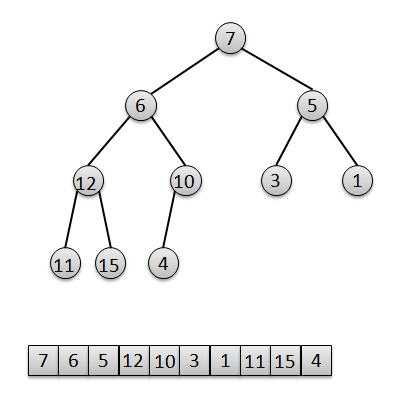
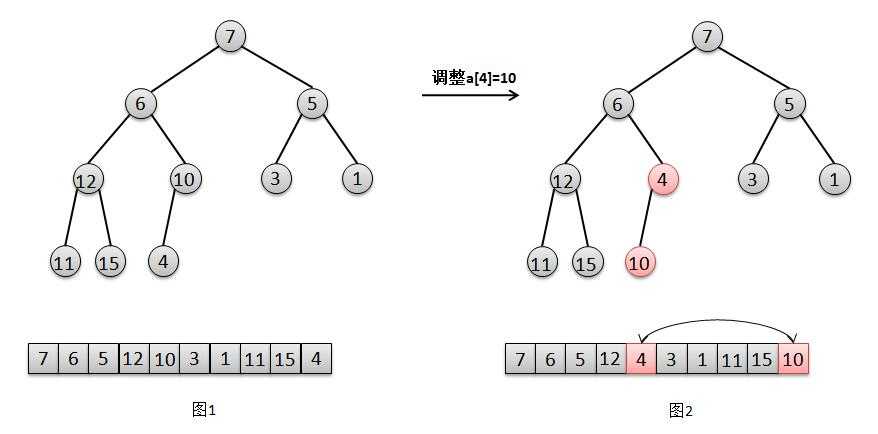
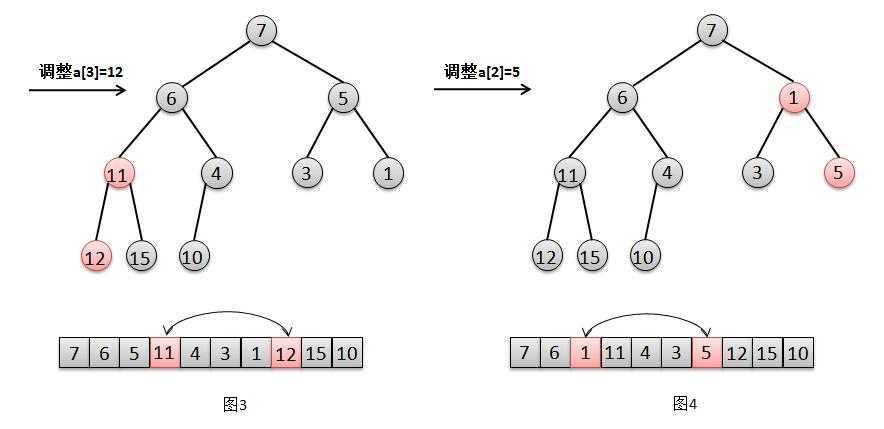
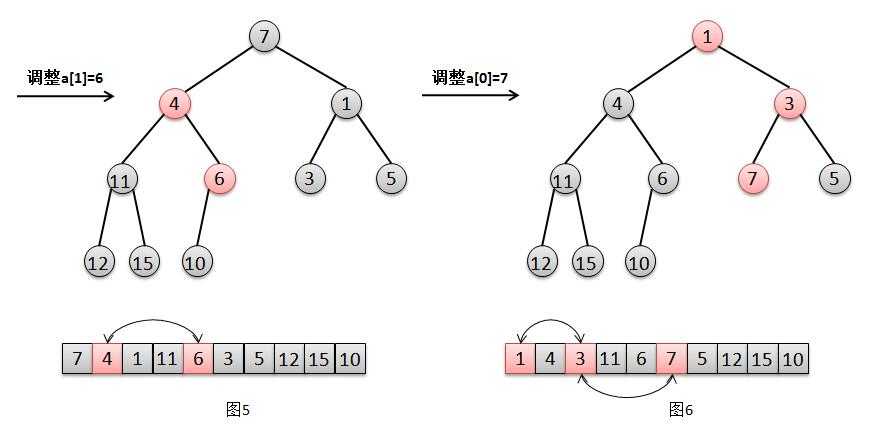
1 private void heapify() { 2 for (int i = (size >>> 1) - 1; i >= 0; i--) 3 siftDown(i, (E) queue[i]); 4 }
给jdk写注释系列之jdk1.6容器(12)-PriorityQueue源码解析
标签:
原文地址:http://www.cnblogs.com/tstd/p/5125949.html